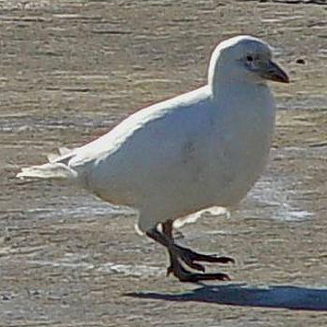|
Chionis albus (Greater
sheathbill, Snowy sheathbill)
[= Chionis alba]
Amerikaanse peddie [Afrikaans]; Grootkokerbek [Afrikaans];
Grootpeddie [Afrikaans]; Grootskedebek [Afrikaans]; Zuidpoolkip [Dutch]; Chionis
blanc [French]; Amerikanischer Scheidenschnabel [German]
Life
> Eukaryotes >
Opisthokonta
> Metazoa (animals) >
Bilateria >
Deuterostomia > Chordata >
Craniata > Vertebrata (vertebrates) > Gnathostomata (jawed
vertebrates) > Teleostomi (teleost fish) > Osteichthyes (bony fish) > Class:
Sarcopterygii (lobe-finned
fish) > Stegocephalia (terrestrial
vertebrates) > Tetrapoda
(four-legged vertebrates) > Reptiliomorpha > Amniota >
Reptilia (reptiles) >
Romeriida > Diapsida > Archosauromorpha > Archosauria >
Dinosauria
(dinosaurs) > Saurischia > Theropoda (bipedal predatory dinosaurs) >
Coelurosauria > Maniraptora > Aves
(birds) > Order: Charadriiformes
> Family: Chionidae
 |
|
|
Greater sheathbill, Cape Town Harbour, South
Africa. [photo Trevor Hardaker ©] |
|
Distribution and habitat
Breeds from April-October on the Antarctic Peninsula and
the islands of South Georgia, South Orkney and South Shetland, heading north in
the non-breeding season to south-eastern South America and the Falkland Islands.
It is a vagrant to South Africa, as it is sighted almost annually at the port of
Cape Town and elsewhere along the south-western coast, suggesting that it gets
to the region by hitching a ride on a ship. It generally prefers rocky
shorelines, although it is regularly recorded at harbours.
References
-
Hockey PAR, Dean WRJ and Ryan PG 2005. Roberts
- Birds of southern Africa, VIIth ed. The Trustees of the John Voelcker
Bird Book Fund, Cape Town.
|
